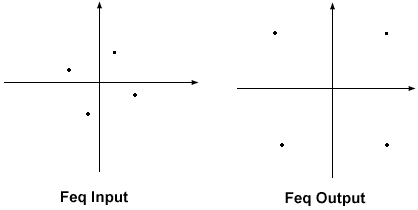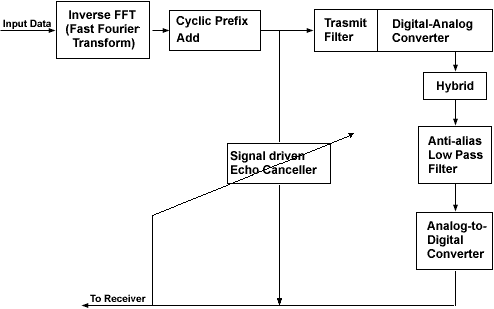|
|
Thesis in Electronics Engineering (DU) on ADSL system with DMT modulation in respect of the Standard ANSI T1.413 |
Frequency equalizer -- FEQ The copper line distorts the signal amplitude and phase, a distortion that changes from carrier to carrier. The frequency equalizer is designed to correct this attenuation and phase shift, see figure 8. The FEQ rotates the received
constellation at each tone for channel phase compensation and
increases the received amplitude in order to correct loop
attenuation.
To support bi-directional channels, vendors may use the Echo Cancellation method in which downstream and upstream bands are overlappingly assigned. This results in both higher duplex components of the ADSL service, and improved downstream performance. The improvement in downstream performance is due to the fact that the lower low attenuation portion of the channel spectrum becomes available for downstream transmission. Echo Cancellation is performed by
generating an exact replica of the transmitted signal that leaks
into the receiver. Upon subtraction of the near-end echo-replica the received far-end signal can be
processed as if its only impairment has been the channel induced
noise sources. Echo cancellation in ADSL must consider the
asymmetric upstream/downstream nature that results in different
sampling rates for upstream and downstream. In Orckit's ORvision
ADSL modem, echo cancellation is performed by implementing advanced
multi-rate filtering techniques. This structure is very much favored
by rapidly decreasing costs of digital signal processing in
VLSI.
Advanced Forward Error Correction (FEC) techniques as well as a 20 ms data interleaver provide the ability to correct error bursts as long as 500 µsec. ADSL modems can therefore tolerate impulses of arbitrary magnitude whose effect on the data stream lasts no longer than 500 µsec. Trials indicate that this level of correction will create effective error rates suitable for MPEG2 and other digital video compression schemes. POTS Splitter ADSL modems usually include a POTS (Plain Old Telephone Service) splitter, which enables simultaneous access to voice telephony and high speed data access. Some vendors provide active POTS splitters, which enables simultaneous telephone and data access; however, if the power fails or the modem fails with an active POTS splitter, then telephone fails. A passive POTS splitter, on the other hand, maintains lifeline telephone access even if the modem fails (due to a power outage, for example), since the telephone is not powered by external electricity. Telephone access in the case of a passive POTS splitter is a regular analog voice channel, the same as customers currently receive to their homes. The POTS splitter is a three node device, that allows the telephony signals and the ADSL signal to reside on the same copper loop, without interfering one with the other. The POTS signal is located in the low frequency band. All the ADSL signals reside at higher frequencies, starting approximately at 25 kHz or above. The POTS splitter provides a low pass filter between the copper line node and the Telephone node, and provides a high pass filter between the copper line node and the ADSL modem node. Thus, between the ADSL node and the telephone node the splitter attenuates all signals. One of the main concerns in the design of the filter is to block impulsive noise coming from the home telephone or narrow band switch at the central office into the ADSL modem. Some of the most severe impulses are generated by the ring trip signal. The filter also blocks the ADSL modem signals from going into the telephone set, reducing the quality of the line. The impedance of telephone wires varies significantly between lines. This depends heavily on the length and gauge of the wire, and also on the telephone itself, when the line is short. The addition of two filters, one at the central office and one at the home, is non trivial, especially if we try to fit just one design to all cases. The echo return loss, which affects the voice band quality of service can not be compromised. Most POTS splitter designs are
passive. The advantages of passive filtering are in their
reliability, since life line services over the telephone wire have
to be supported. No powering is required, and the passive filters
are much better protected from the lightning that may be coupled
through the line. In some countries, performance requirements
require active filters in the POTS splitters. Line condition measurements The ADSL inherently measures the line attenuation and noise power in each carrier. We do so in order to measure and monitor the signal to noise ratio of each tone. We can see that with no extra complexity, we have a built in FFT spectrum analyzer, that operates continuously measuring the signal and noise. Since we use no windowing in our FFT processing, our spectrum analyzer has high sidelobes, however, for the typical scenarios encountered on copper loops this resolution is good enough. The Orckit ORvision modem uses this capability to record and report the loop and noise conditions. When analyzed, this information is extremely valuable to the operator, since we can predict the performance, identify sources of interference, qualify copper loops and continually reduce the cost of installation of ADSL modems.
1 |
2 | 3
|

